|
|
Outrcrop
description based on Keller (1984)
1.
Quarry
Hauri
wollastonite
bearing phonolite, Fohberg/Bötzingen-Oberschaffhausen
R:
3403500 H: 5327400
|
Phonolitic
intrusion body 600 x 400 meter in diameter in the last active quarry in
the Kaiserstuhl volcanic complex, own by the family Hauri. The phonolit
intruded into the Pechelbronner unite of Oligocene age.
The Intrusion is characterized by a wollastonite (CaSiO3)
content, whereas wollastonite crystallized during magmatic
fractionation. These theory is supported be the bulk rock chemistry
with a high CaO content at high alkalinity, which express by an
agpaitic index of 0.9. Xenolith of gneissic and granitic origin,
showing metasomatic fenitisation occur beside xenolith of sedimentary
units. Sporadical essexitic dikes crosscut the intrusive body.
The primary phonolitic mineralogy is highly hydrothermal altered,
whereas nepheline is altered to natrolite (zeolite). Zeolites and other
secondary minerals, like calcite and apophyllite are found on fissure,
which are interested for mineral collectors.
In former time quarrying was done for gravel production. Due to the
chemical behaviour of natrolite as good cation exchanger, the phonolite
powder is used in the concrete industry, in medicinial products, glass
industry, agriculture, forestry and environment (e.g. flue gas
detoxification). |
| SiO2 |
49,28 |
|
sanidine |
31,7 vol.
% |
| TiO2 |
0,34 |
|
natrolite |
45,0
vol. % |
| Al2O3 |
17,92 |
|
wollastonite |
10,0
vol. % |
| Fe2O3
|
2,44 |
|
calcite |
1,1
vol. % |
| FeO |
1,43 |
|
augite |
9,3
vol. % |
| MnO |
0,28 |
|
melanite |
1,0
vol. % |
| MgO |
0,66 |
|
apatite,
titanite |
0,5
vol. % |
| CaO |
7,32 |
|
magnetite |
0,5
vol. % |
| Na2O |
6,81 |
|
goetzenite |
1,1
vol. % |
| K2O |
0,86 |
|
|
|
| P2O5 |
0,14 |
|
|
|
| CO2 |
2,01 |
|
|
|
| H2O |
4,68 |
|
|
|
|
|
|
|
|
| total |
98,47 |
|
|
|
chemistry
and modal mineral conent of the Fohberg phonolite (ALBRECHT1981)
|
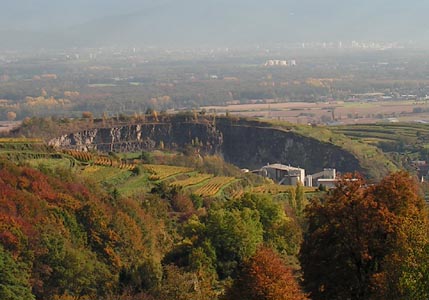
quarry
Hauri,
Bötzingen (view from Vogelsangpass)
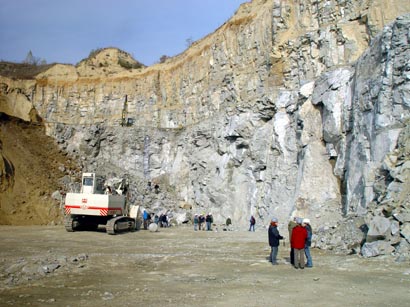
quarry
Hauri
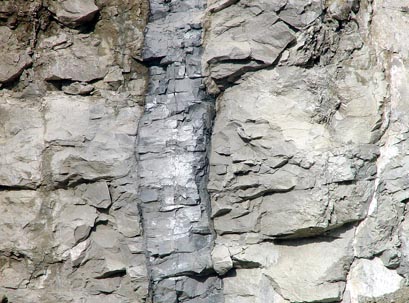
essexitic
dike crosscut the phonolitic intrusion
|
2.
Soevite, carbonatite, Orberg/Schelingen
Bruch V:
R: 3402650 H: 5330490
Bruch
III: R: 3402580 H: 5330380
|
| The
Orberg quarry V point out an igneous layering of the coarse grained
carbonatite, which is defined as soevite. Coarse grained calcite
crystals up to 30 cm are found. Quarry II which stretch from the
district road up to quarry V point out the dike nature of the
carbonatitic intrusion, associate with highly greenish altered
diatremic breccias. Calcite is by fare the frequent mineral content up
to 90 volume per cent of the carbonatite. Addionally magnite, appatite,
Mg-rich forsterite, phlogophite and cherry-red koppite (pyhrochlor)
occur. |
|
1 |
2 |
3 |
| SiO2 |
1,37 |
1,69 |
1,27 |
| TiO2 |
0,05 |
0,09 |
0,16 |
| Al2O3 |
0,35 |
0,48 |
0,54 |
| Fe2O3 |
3,18 |
3,03 |
2,24 |
| MnO |
0,42 |
0,69 |
0,32 |
| MgO |
3,05 |
0,73 |
0,58 |
| CaO |
48,60 |
49,00 |
52,36 |
| Na2O |
0,10 |
0,08 |
0,10 |
| K2O |
0,03 |
0,09 |
0,05 |
| P2O5 |
2,87 |
1,74 |
1,47 |
| CO2 |
37,20 |
38,40 |
27,20 |
| H2O |
-- |
-- |
1,85 |
|
|
|
|
| total |
37,20 |
96,02 |
98,36 |
chemcial analysis of crabonatite
1
soevite, Orberg Schelingen (KELLER 1984)
2
average of 52 alvikitic dikes (KATZ & KELLER 1981)
3
carbonatitic lapilli stone, Henkenberg (KERLLER 1981)
|
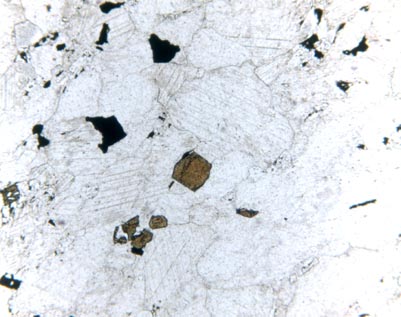
carbonatite
thin section, image width: 3,7 mm

quarry
V Orberg,
Schelingen
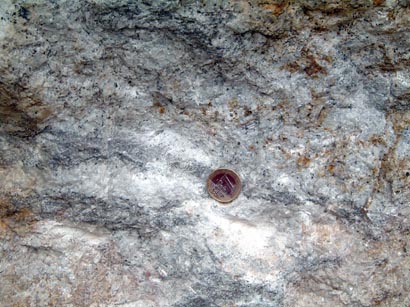
soevite |
3.
Phonolitic intrusion,
Kirchberg/Niederrotweil
R:
3396700 H: 5528100
|
| Sodalite
bearing phonolite intrusion in the old Kirchberg quarry. The
contact to the country rock is exposed in the SE corner of the quarry,
whereas the temporal position of the intrusion is visible. The country
rocks exists of tephritic agglomerates. The quarry is famous for
findings of melanite, apophyllite, fluorite, calcite and natrolite. But respect the closure of the
quarry during the first half of the year, because of nature protection. |
| SiO2 |
55,79 |
|
K-feldspar |
61,0
vol. % |
| TiO2 |
0,31 |
|
plagioclase |
2,0 vol. % |
| Al2O3 |
19,45 |
|
sodalite-hauyn |
28,0 vol.
% |
| Fe2O3 |
2,77 |
|
augite |
3,5 vol. % |
| FeO |
0,67 |
|
melanite |
1,5 vol. % |
| MnO |
0,23 |
|
ore |
2,0 vol. % |
| MgO |
1,63 |
|
calcite |
1,5 vol. % |
| CaO |
2,13 |
|
apatite,
tinatite |
0,5 vol. % |
| Na2O |
7,94 |
|
|
|
| K2O |
5,44 |
|
|
|
| P2O5 |
0,06 |
|
|
|
| H2O |
1,16 |
|
|
|
| CO2 |
0,22 |
|
|
|
| SO3 |
0,94 |
|
|
|
|
|
|
|
|
| total |
98,74 |
|
|
|
chemcial
composition of the Kirchberg phonolite (WIMMENAUER 1962)
|

phonolite,
Kircherg quarry |
exctrusive
carbonatite
4.
Henkenberg/Niederrotweil
R:
3396350 H: 5329380
5. Kirchberg/
Niederrotweil
R: 3396850
H: 5328000 |
|
Extrusive
carbonatite occur only at two places in the Kaiserstuhl volcanic
complex: Henkenberg and Kirchberg. In both cases the carbonatitic
lapillistone consists round to tear-shape lapillis. Tace element
characterisation of the chemical composition reflects alvicitic
affiliation with a trachytoidal structure. The localities provides as
world wide standart for extrusive carbonatite products.
The Henkenberg outcrop is nearly vanished,
whereas only few field stones can be find. In contrast the Kirchberg
outcrop exhibit nice outcrop conditions de to the recent vineyard
consolidation.
Tace element characterisation of the chemical
composition reflects alvicitic affiliation with a trachytoidal
structure. The localities provides as world wide standart for extrusive
carbonatite products. The lapilli stone consists mainly on calcite,
with minor amounts of apatite and magnetite with accessoric augit,
melanite, Nb- perovskite and pyrochlor
The Henkenberg Lapilli stone overlays the
Henkenberg tuff breccia, witch contains soevitic xenoliths.
|
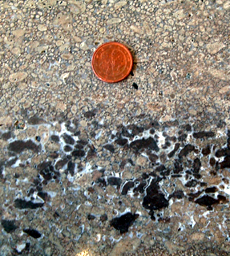
carbonatitic
lapilli stone |
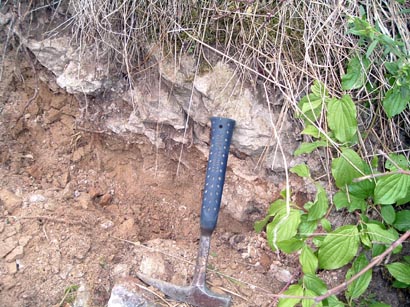
outcrop
"Blutten
Bückele", Kirchberg/Niederrotweil
carbonatitic lapilli stone overlays phonolitic
tuff
(17,2
±0,1 Ma) |
Tephrite
6. Humberg,
Sponeck, between Burkheim and Jechtingen
R:
3394900 H: 5331300
7.
Büchsenberg near Achkarren
R:
3396270 H: 5326880
|
|
Tephrites
and the porhphyric subvolcanic equivalent essexites mark the most
abundant rock type in the Kaiserstuhl volcanic complex. The best
outcrops conditions are along the western flanks of the Kaiserstuhl,
whereas the Humber-Sponeck complex as well as the Büchsenberg
are nice localities. Both are leucite- beraing tephrites formed by
parasitic volcanos on the flank of the Kaiserstuhl volcanic complex,
consisting of alternating lava flows, agglomerates formed by
strombolian eruption type activity and sills.
The Sponeck ruin is build on a shallow, neat
surface essexite intrusion, whereas a grain size increase with depth
can be seen.
The petrographic composition varies in a small
range with Ti-augite as characteristic dominating phase (25-35 vol. %).
Olivine can be found in a few samples. Plagioclase do not present a
liquidus phase and appear only in a few sample as phenocryst generation.
Leucite marks the most frequent feldspathoid,
however it is fully replace by analcime. Nepheline tephrites accure
rarely and sometimes soldaite, K-feldspar, biotite and amphibole are
found. Classification by using the QAPF diagram
(Streckeisen diagram) results in phonolitic tephrites. Mg-numbers
cumulate between 50 and 55, which illustrates a medium fractionation
degree. Age dating have shown that tephrites
were erupted during the whole magmatic activity of the Kaiserstuhl
complex.
|
| |
1 |
2 |
3 |
| SiO2 |
45,44 |
43,34 |
46,76 |
| TiO2 |
2,88 |
2,64 |
1,58 |
| Al2O3 |
14,15 |
15,72 |
17,63 |
| Fe2O3 |
7,24 |
5,42 |
8,63 |
| FeO |
4,71 |
5,79 |
4,45 |
| MnO |
0,16 |
-- |
-- |
| MgO |
5,11 |
5,49 |
3,68 |
| CaO |
12,88 |
12,49 |
10,52 |
| Na2O |
1,98 |
3,29 |
2,70 |
| K2O |
3,23 |
2,24 |
1,68 |
| CO2 |
-- |
0,14 |
0,40 |
| P2O5 |
0,54 |
0,27 |
0,29 |
| H2O |
1,84 |
2,70 |
2,37 |
| Cl |
0,13 |
0,12 |
-- |
|
|
|
|
| total |
99,69 |
99,74 |
100,60 |
|
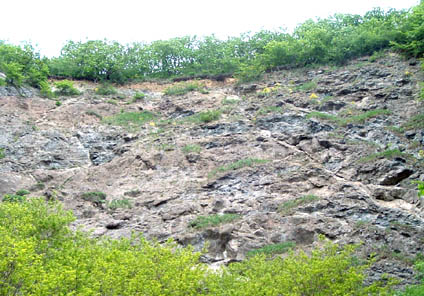
quarry
Büchsenberg nearAchkarren,alternating tephritic lava flows and
pyroclastic units
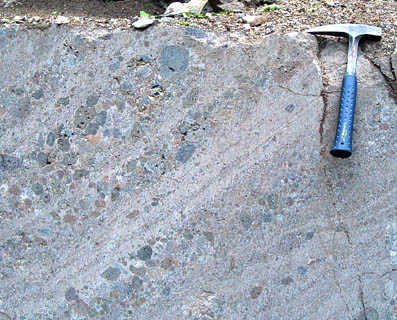
tephritic
agglomerate,
Schloßberg/Achkarren |
chemical analysis:
1 leucitetephrite, Bitzenberg near Bickensohl
2 leucite-free tephrite, Eichert (MEIGEN & STECHER 1920)
3 essexite,
Sotenkopf (SOELLNER 1928) |
|
8.
Olivine-nephelinite
Lützelberg/Sasbach
R:
3396630 H:
5334900 |
The outcrop
“Bierkeller” at the northern flank of the
Lützelberg, you can stop at an layby apprixomatelly 500 meter
west on the old district road from Sasbach to the Rhine river
2 to 3 olivine-nephelinite lava flows build up
the Lützelberg mountain, which are devided by agglomerates of
the same chemical composition, which are associated with a scoria cone
that is exposed in the Limberg quarry VII. The Bierkeller outcrop
expose a multiplicity of head-size spheres, up to 25 cm in diameter.
Theses spheres are mantel xenolith. The outcrops mark the riches mantel
xenolith locality in the Teritary volcanic province in Soutwestern
Germany. The Xenolith contains strongly altered olivine, Cr- spinel,
orthopyroxene and clinopyroxene. Additionally Al-rich clinopyroxene
megacrysts are found. Clinopyroxene thermbarometry data yields a source
depth of around 100 km.
The olivine-nephelinite as host rocks, are
characterized by high values of Ni, Cr and a high Mg number, which
markets the most primitive volcanic products in the Kaiserstuhl
volcanic. These indicate a fast ascent of the magma.
Age dating of the The olivine-nephelinite lava
flows yields ages of 16.2 million years.
|
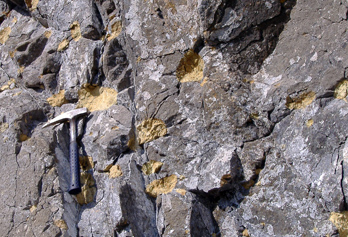
spinel-lherzoliths
|
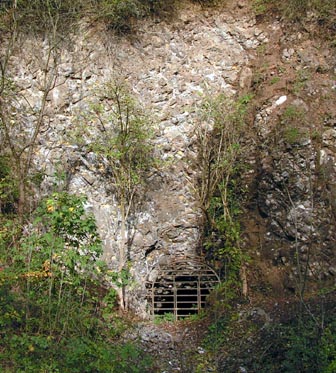
locality"Bierkeller",
Lützelberg |
9.
Limberg/Sasbach
quarry
I:
R:
3396100 H: 5335680
quarry VII: R:
3396300 H: 5335200
|
|
Limberg
quarry I expose 2 lava flows (λ1
and λ2),
each up to 20 meter in thickness. Theses lava flows are divided a tuff
layer t1, a significant marker for the Limberg-Lützelberg
complex
stratigraphy that contains phonolitic components fragments of
olivine-nephelinite and xenolith of lherzolith.
The lower lava flow λ1
shows characteristic pahoehoe structures of low viscosity flow
conditions. The upper limburgite lava flow λ2
in contrast is characterized by Aa-lava type formation. The breccias
appearance is cause by abrupt evaporation of water und thereby the huge
volume increase during that process.
Partially the tuff layer is injected along
vertical
structures into the upper lava flow, which is also cause by the rapid
evaporation.
Both lava flows are defined as limburgites. This
term
is introduced by Rosenbusch and defined as volcanic rocks with a
vitreous matrix and mafic phenocrysts. Phenycrsyts thereby are olivine,
magnetite and Ti-augite.
Geochemically the limburgites are of basanitic
composition and display beside the olivine-nephelinites from
Lützelberg the most primitive volcanic products.
The vitreous matrix often shows palagonitization
,
whereas elements leached during that process re-precipitates as
secondary minerals, like various zeolites (faujasit,
offretite,
phillipsite, ...) and carbonates.
A volcanotectonic cross-section is exposed in the Limberg quarry VII.
The Limberg Graben strikes in NW-SE direction. The graben shoulders are
formed by red olivine-nephelinite agglomerates and the NE graben fault
is easily visible. The red wall marks the fault plane. The large
volcanic bomb sizes suggest that the former vent is in near distance.
The composition of the agglomerates are equeal to he
olivine-nephenlinites suggesting that Lützelberg lavas were
erupted on the SE site of the Limberg. The inner graben part is build
up the Limburgite lava units λ2
and yellow-brownish limnic sediments of Miocene age (Burdigal), which
can be dated with fossils. This sediment are overlain by the Limburgite
lava flow unit λ3.
|
|
1 |
2 |
|
|
|
| SiO2 |
41,66 |
41,47 |
|
Ti-augit |
31,5 vol.
% |
| TiO2 |
3,33 |
2,84 |
|
olivine |
10 vol. % |
| Al2O3 |
11,45 |
11,91 |
|
magnetite |
5 vol. % |
| Fe2O3 |
5,16 |
10,99 |
|
groundmass |
53,5 vol.
% |
| FeO |
6,72 |
4,04 |
|
|
|
| MnO |
0,15 |
-- |
|
|
|
| MgO |
11,55 |
6,56 |
|
|
|
| CaO |
12,23 |
13,87 |
|
|
|
| Na2O |
2,50 |
3,97 |
|
|
|
| K2O |
1,20 |
1,58 |
|
|
|
| P2O5 |
0,70 |
0,57 |
|
|
|
| CO2 |
0,75 |
0,75 |
|
|
|
| H2O |
2,30 |
1,95 |
|
|
|
|
|
|
|
|
|
| Sum |
99,70 |
99,69 |
|
|
|
chemcial analysis
1 limburgite λ1
(KELLER
1990)
2 limburgite
λ2 (MEIGN
& STECHER,1930)
3 average
limburgite L(WIMMENAUER 1959)
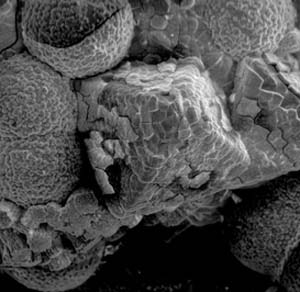 faujasite
found in quarry I
faujasite
found in quarry I
|
Limberg quarry ViI, olivine-nephelinite
agglomerate
with volcanic bombs
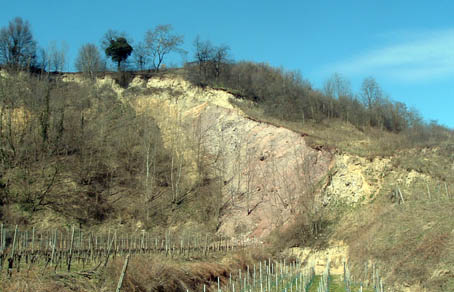
Limberg quarry VII showing the limberg graben
fault

Limberg quarry VII; olivine-nephelinite
aglomerate with volcanic bombs and oxidized xenolits, containing fresh
Cr- diopside

Limberg
quarry 1: lava flow λ1 and λ2 are
devided by tuff layer |
|